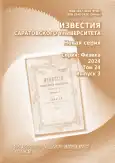Modification of cerium oxide nanoparticles with polymeric materials
- Authors: Kovyrshina A.A.1, Tsyupka D.V.1, Popova N.R.2,3, Goryacheva I.Y.1, Goryacheva O.A.1
-
Affiliations:
- Saratov State University
- Institute of Theoretical and Experimental Biophysics, Russian Academy of Sciences
- Institute of Biochemistry and Physiology of Plants and Microorganisms, Russian Academy of Sciences (IBPPM RAS)
- Issue: Vol 24, No 3 (2024)
- Pages: 281-289
- Section: Nanotechnologies, Nanomaterials and Metamaterials
- URL: https://journals.rcsi.science/1817-3020/article/view/265419
- DOI: https://doi.org/10.18500/1817-3020-2024-24-3-281-289
- EDN: https://elibrary.ru/WLYPMD
- ID: 265419
Cite item
Full Text
Abstract
About the authors
Anastasia Alekseevna Kovyrshina
Saratov State University
ORCID iD: 0009-0001-5406-6828
410012, Russia, Saratov, Astrakhanskaya street, 83
Daria Vladislavovna Tsyupka
Saratov State University410012, Russia, Saratov, Astrakhanskaya street, 83
Nelli R. Popova
Institute of Theoretical and Experimental Biophysics, Russian Academy of Sciences; Institute of Biochemistry and Physiology of Plants and Microorganisms, Russian Academy of Sciences (IBPPM RAS)
ORCID iD: 0000-0002-0982-6349
3 Institutskaya St., Pushchino, Moscow region 142290, Russia
Irina Yurievna Goryacheva
Saratov State University410012, Russia, Saratov, Astrakhanskaya street, 83
Olga A. Goryacheva
Saratov State University
ORCID iD: 0000-0002-0910-7694
Scopus Author ID: 56429460900
ResearcherId: I-3326-2017
410012, Russia, Saratov, Astrakhanskaya street, 83
References
- Korsvik C., Swanand P., Sudipta S., William T. S. Superoxide dismutase mimetic properties exhibited by vacancy engineered ceria nanoparticles. Chemical Communications, 2007, vol. 10, pp. 1056–1058. https://doi.org/10.1039/B615134E
- Thakur N., Prasenjit M., Joydeep D. Synthesis and biomedical applications of nanoceria, a redox active nanoparticle. Journal of Nanobiotechnology, 2019, vol. 17, no. 1, article no. 84. https://doi.org/10.1186/s12951-019-0516-9
- Zholobak N. M. Interaction of nanoceria with microorganisms. Nanobiomaterials in Antimicrobial Therapy, 2016, vol. 6, pp. 419–450. https://doi.org/10.1016/B978-0-323-42864-4.00012-9
- Xu C., Qu X. Cerium oxide nanoparticle: A remarkably versatile rare earth nanomaterial for biological applications. NPG Asia Mater., 2014, vol. 6, no. 3, pp. e90. https://doi.org/10.1038/am.2013.88
- Skorodumova N. V., Simak S. I., Lundqvist B. I., Abrikosov I. A., Johansson B. Quantum Origin of the Oxygen Storage Capability of Ceria. Physical Review Letters, 2002, vol. 89, no. 16, article no. 166601. https://doi.org/10.1103/PhysRevLett.89.166601
- Kargozar S., Baino F., Hoseini S. J., Hamzehlou S., Darroudi M., Verdi J., Hasanzadeh L., Kim H.-W., Mozafari M. Biomedical applications of nanoceria: New roles for an old player. Nanomedicine, 2018, vol. 13, no. 23, pp. 3051–3069. https://doi.org/10.2217/nnm-2018-0189
- Aleksandrov H. A., Neyman K. M., Hadjiivanov K. I., Vayssilov G. N. Can the state of platinum species be unambiguously determined by the stretching frequency of an adsorbed CO probe molecule? Phys. Chem. Chem. Phys., 2016, vol. 18, no. 32, pp. 22108–22121. https://doi.org/10.1039/C6CP03988J
- Kullgren J., Hermansson K., Castleton C. Many competing ceria (110) oxygen vacancy structures: From small to large supercells. The Journal of Chemical Physics, 2012, vol. 137, no. 4, article no. 044705. https://doi.org/10.1063/1.4723867
- Renu G., Rani V. V. D., Nair S. V., Subramanian K. R. V., Lakshmanan V.-K. Development of Cerium Oxide Nanoparticles and Its Cytotoxicity in Prostate Cancer Cells. Advanced Science Letters, 2012, vol. 6, no. 1, pp. 17–25. https://doi.org/10.1166/asl.2012.3312
- Lin W., Huang Y., Zhou X.-D., Ma Y. Toxicity of Cerium Oxide Nanoparticles in Human Lung Cancer Cells. International Journal of Toxicology, 2006, vol. 25, no. 6, pp. 451–457. https://doi.org/10.1080/10915810600959543
- Rajeshkumar S., Naik P. Synthesis and biomedical applications of Cerium oxide nanoparticles – A Review. Biotechnology Reports, 2017, vol. 17, pp. 1–5. https://doi.org/10.1016/j.btre.2017.11.008
- Shabrandi A., Azizi S., Hobbenaghi R., Ownagh A., Keshipour S. The healing effect of chitosan supported nano-CeO2 on experimental excisional wound infected with pseudomonas aeruginosa in rat. IJVS, 2017, vol. 12, no. 2, pp. 9–20. https://doi.org/10.22034/ivsa.2017.94632.1122
- Sulthana S., Banerjee T., Kallu J., Vuppala S. R., Heckert B., Naz S., Shelby T., Yambem O., Santra S. Combination Therapy of NSCLC Using Hsp90 Inhibitor and Doxorubicin Carrying Functional Nanoceria. Molecular Pharmaceutics, 2017, vol. 14, no. 3, pp. 875–884. https://doi.org/10.1021/acs.molpharmaceut.6b01076
- Hasanzadeh L., Darroudi M., Ramezanian N., Zamani P., Aghaee-Bakhtiari S. H., Nourmohammadi E., Kazemi Oskuee R. Polyethylenimine-associated cerium oxide nanoparticles: A novel promising gene delivery vector. Life Sciences, 2019, vol. 232, article no. 116661. https://doi.org/10.1016/j.lfs.2019.116661
- Shcherbakov A. B., Reukov V. V., Yakimansky A. V., Krasnopeeva E. L., Ivanova O. S., Popov A. L., Ivanov V. K. CeO2 Nanoparticle-Containing Polymers for Biomedical Applications: A Review. Polymers, 2021, vol. 13, no. 6, article no. 924. https://doi.org/10.3390/polym13060924
- ImageJ: Image Processing and Analysis in Java. Available at: https://imagej.net/ij/index.html (accessed April 20, 2024).
- Ivanov V. K., Shcherbakov A. B., Usatenko A. V. Structure-sensitive properties and biomedical applications of nanodispersed cerium dioxide. Russian Chemical Reviews, 2009, vol. 78, no. 9, pp. 855–871. https://doi.org/10.1070/RC2009v078n09ABEH004058
- Anisimov M. P. Nucleation: Theory and experiment. Russian Chemical Reviews, 2003, vol. 72, no. 7, pp. 591–628. https://doi.org/10.1070/RC2003v072n07ABEH000761
- Moore T. L., Rodriguez-Lorenzo L., Hirsch V., Balog S., Urban D., Jud C., Rothen-Rutishauser B., Lattuada M., Petri-Fink A. Nanoparticle colloidal stability in cell culture media and impact on cellular interactions. Chem. Soc. Rev., 2015, vol. 44, pp. 6287–6305. https://doi.org/10.1039/C4CS00487F
Supplementary files









